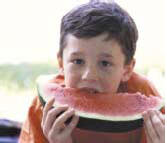|
Germinating
watermelon
seed
Lefroy Valley Magazine
June 2003
Germination is often thought of as the
whole process from sowing until the full
emergence of the two cotyledon
leaves.
There are, in fact, two vastly different
phases during this period, namely (i)
germination and (ii) growth of the radicle
and hypocotyl until emergence. If
both of these phases are better understood
and dealt with separately, less
problems would occur during these initial
stages of plant production. In this article,
seed dormancy, germination, and
seedling propagation of watermelon seed
will briefly be addressed.
Seed Germination
Germination is a complex physiological
process with photo-dependency,
initiated by water absorption during a
period of optimum temperatures.
When these three criteria are met,
seed dormancy is lifted and the
radicle emerges, signalling the end of
the germination process.
Sowing Depth in the Field
The size of a seed is a good indication
of its optimum sowing
depth. When seed is sown too
deep, most of the reserves in the
endosperm will be used for
germination and radicle growth, leaving
very little for further development. A
good rule of thumb is to sow at a depth
of four times the seed width.
Seeded Watermelon(Diploid)
The seed absorbs water for its metabolic
processes, embryo expansion, and radicle
and hypocotyl growth. Because of its
size, watermelon seed requires more
water during the initial stages of germination
than smaller seed varieties do. If
germination takes place at relative
humidity of 90%, no additional water is
required during the first three days
after sowing.
Over-watering, especially during cooler periods, will result in a
lowered respiration rate and less energy production. Together with
seedlings stretching in low light and unhygienic sowing conditions,
over-watering also increases the susceptibility of seed and
seedlings to water-borne pathogens. Using the water disinfectant
Sporekill and incorporating the bio-inoculant
Trichoderma into the seedling growth medium limits the damage caused
by these pathogens. The optimal temperature range for successful and
uniform germination is a constant 23 - 25°c for the first three days
after sowing. However, good results have also been observed at 30°c
(day) and 20°c (night).
Seedless Watermelon
Water uptake through the seed coat is slower in seedless
watermelons, compared to normal watermelon, which means that the
seed can easily be suffocated. When there is excess soil moisture,
different procedures should be observed.
Procedure for germinating seedless
melons in transplant trays:
Prior to sowing, pre-wet a light seedling mix with approx 500ml
of water for every 1000gm of mix and pre-heat in a germination
room overnight at 30oc.
-
Sow seed into
indentations using warm seedling mix at 1 cm depth and cover
lightly with same warm mix or Vermiculite. DO NOT WATER.
-
Seed coat
adherence to cotyledons can be virtually eliminated by
placing the seed in the transplant trays pointy end up at
45-90o angle (may not be a practical option for Nursery
production).
-
Place in
germination room at 30oc at high humidity and remove when
most radicles have emerged.
-
Move trays to
greenhouse and hold at 27oc until emergence is complete. The
high temperature assists uniform emergence.
-
Water only as
necessary irrigate sparingly for the first week. DO NOT OVERWATER. Plants should be hardened off by reducing irrigation
and transplanted at third true leaf stage.
Seedling Propagation
The greenhouse structure should be sterilized and all sources of
possible contamination should be removed before the arrival of the
seedling trays. A preventative program against insect virus vectors
should also be followed. The optimum air and root-zone temperatures
in the structure are 27°c and 19°c, respectively.
Night temperatures below 13°c result in slow growth and cold stress,
increasing susceptibility to disease.
A relative humidity of 70% is preferable, but good ventilation
throughout the day is even more important. Ventilation is necessary
for optimal CO2 levels within the structure and for removing any
free-water from the leaf surfaces. High light intensity within the
structure ensures sturdy compact seedlings.
 |
Transplanting
Watermelons are
frost-sensitive and should only be transplanted in warm,
well watered soil. Transplant shock can be minimized by
transplanting in the afternoon or by using the anti-transpirant
Vapor Guard. Apply Kic Start during cool transplant
periods. Seedling growth is boosted, as it promotes
early root growth, which is the first priority after
transplanting. |
Seed storage
Watermelon seed will last 3 - 4 years when kept dry (10 - 15% seed
moisture content), and at cool, constant temperatures (14 - 20°c).
Seed packaging opened too long before sowing, and frequent and rough
handling will lower watermelon seed viability.
|